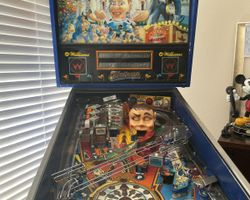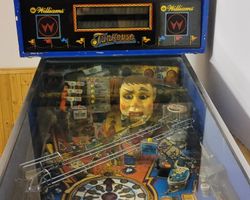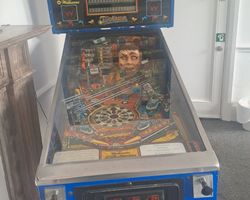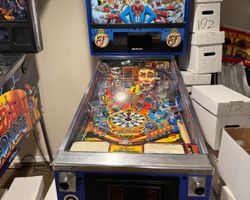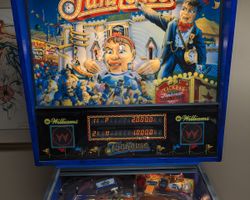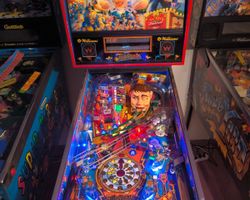Funhouse
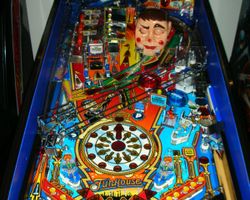
Average Prices: USD $1,000 to $4,500
Produced: November, 1990
Production Run: 10,750 units
Machine Type: Solid State Electronic
MPU: Williams WPC (Alpha Numeric)
Players: 4
Concept by: Pat Lawlor
Design by: Pat Lawlor, Larry DeMar
Art by: John Youssi
Mechanics by: John Krutsch
Music by: Chris Granner
Sound by: Jon Hey
Software by: Larry DeMar, Brian Eddy
Williams Electronic Games, Inc. introduced Funhouse to the pinball world in November 1990, a machine that quickly carved out a unique space in the hearts of players. Conceived by the design team of Pat Lawlor and Larry DeMar, with art by John Youssi, music by Chris Granner, and sounds by Jon Hey, Funhouse transported players into an unsettling yet captivating carnival atmosphere. A distinctive character-driven theme featuring a mischievous, talking dummy named Rudy became the centerpiece. This design built upon a prior Williams pinball machine from 1956 also titled 'Fun House,' which included three trap doors. The production run for Funhouse was robust, with approximately 10,751 units manufactured, signaling its immediate popularity and demand.
The development of Funhouse involved detailed mechanical and software efforts. Larry DeMar handled the software, with Brian Eddy contributing to display effects and flasher synchronization. John Krutsch was responsible for the mechanical engineering. A notable piece of trivia from the development phase involves an early design for a mechanical clock, more intricate than the final version, which was ultimately deemed unreliable and too costly for the production timeline. This design would later inspire elements in Twilight Zone. Another interesting aspect was the early decision to use Williams System 11 sound boards, adapted to the WPC system, for initial production models, as the dedicated WPC sound board was not yet ready. Furthermore, a small number of early playfields, about 200, featured a "Diamond Plate" clear coat, a detail sought by some collectors. Early marketing flyers also reveal subtle differences, such as five targets spelling S-T-E-P-S instead of the four "S-T-E-P" targets seen in production machines, and a slightly different appearance for Rudy.
The most defining element of Funhouse is Rudy, an animatronic dummy head mounted on the playfield. Rudy engages players with custom speech callouts, famously voiced by Ed Boon, the sound designer known for his work in other mediums. Rudy's eyes track the ball, and his mouth opens for critical shots, creating a direct, interactive challenge. This animatronic integration was a significant leap for pinball, offering a character interaction that went beyond static toys. Another distinctive feature is the physical clock located prominently on the playfield, which ticks down to midnight, building tension and indicating progression towards the main objective. The game also uniquely features two manual plungers, allowing for varied skill shots and strategic starts. A diverter on the main ramp provides dynamic shot variation, guiding the ball either to the left inlane for another shot or to the left outlane, demanding precision from the player for a skill shot attempt. Additionally, an upper loop features a "trapdoor" that briefly opens, requiring a quick, accurate shot to access it. All Funhouse machines left the factory with translites, not screened glass, a detail confirmed by Pat Lawlor. These combined elements contribute to an experience that feels alive and responsive, drawing players deeper into the carnival world.
The playfield of Funhouse is a masterclass in layout design, immediately drawing attention to Rudy and the central clock. The flow is intuitive yet offers challenges, guiding the player's eye and ball path around the central figure. Major shots include the left ramp, which feeds a diverter that can send the ball to the left inlane or an outlane, setting up a perilous skill shot from the left plunger. Three "cellar holes" positioned strategically offer scoring opportunities and initiate various modes. Four standup targets spell out "S-T-E-P," progression on which contributes to a valuable bonus. A three-bank standup target further adds to the target variety. Three pop bumpers located at the top center of the playfield keep the ball active and unpredictable. The upper loop, featuring the trapdoor, is a high-value shot requiring precision. The artwork by John Youssi is vibrant and detailed, perfectly capturing the unsettling charm of an amusement park at night. The color palette—dominantly reds, yellows, and blues—enhances the carnival theme. Lighting is intelligently used to guide players towards objectives, particularly the segments of the clock and mode indicators, while contributing to the overall eerie, playful ambiance. The aesthetic coherence between the artwork, lighting, and mechanical features immerses the player in Rudy's world.
Gameplay in Funhouse centers around advancing the playfield clock to midnight. Each successful shot to specific targets, ramps, or cellar holes advances the clock's hand. As the clock progresses towards midnight, Rudy's callouts intensify, building anticipation. When the clock strikes midnight, Rudy's mouth opens, signaling the opportunity for the primary objective: shooting the ball into his mouth. A successful shot into Rudy's mouth at midnight awards a substantial 1,000,000 points and initiates "Midnight Multiball," a three-ball multiball mode that allows for high scoring opportunities. Beyond this central objective, players engage in a variety of modes triggered by shooting the cellar holes, each offering different challenges and scoring avenues. The dual plungers offer a strategic choice at the start of each ball: the main plunger for a typical launch, and a secondary plunger for a skill shot to the left outlane, potentially setting up a valuable bonus. Player strategies often revolve around consistently hitting the ramp to advance the clock, then aiming for Rudy's mouth with precision when the time is right. Managing the three-ball multiball adds a layer of chaos and skill, demanding control under pressure. The progression is clear but the execution demands consistent play, making it a game that is easy to understand but challenging to master.
Funhouse received overwhelmingly positive feedback from the pinball community. Its strengths are frequently cited, with Rudy being the most celebrated feature. Players consistently praise his interactive nature, varied sayings, and the satisfying feeling of hitting the ball into his open mouth. The gameplay is widely regarded as challenging, deep, and highly replayable, maintaining engagement for both casual players and those seeking mastery. The overall theme and John Youssi's artwork are praised for their originality and vibrant execution, creating a cohesive and compelling world. Chris Granner's music and Jon Hey's sound effects, particularly Rudy's voice work by Ed Boon, are considered integral to the game's personality, contributing to its lasting appeal. Many players express a strong desire to own a Funhouse machine, testament to its addictive and enjoyable nature.
However, some aspects have received minor critiques. A small segment of players find Rudy's appearance to be unsettling, which can detract from their enjoyment. Some reviewers note that the gameplay flow can sometimes feel "stop and go" or repetitive, particularly the central objective of repeatedly putting Rudy to sleep. A few players perceive the playfield layout as somewhat cramped or the shots occasionally awkward, although this is a less common sentiment. There have also been comments regarding the sound quality being slightly muffled, especially Rudy's speech, which might be attributed to the early sound board configurations. Additionally, a minor point of feedback cited a lack of a clear narrative or story progression beyond the central objective. Despite these minor criticisms, Funhouse's legacy remains firmly established. It is widely considered a classic and often appears on lists of top pinball machines. Its innovative use of animatronics and strong character integration set a precedent, influencing future pinball designs that sought to create more immersive, character-driven experiences. Funhouse stands as a significant title in pinball history, known for its strong theme, innovative features, and enduring replayability.
Sponsored Links
 Ebay Listings
Ebay Listings
 Auction Results
Auction Results
| Cost | Location | Date |
|---|---|---|
| USD $4,500 |  Maryland, United States Maryland, United States |
06 November, 2025 |
| USD $6,200 |  Texas, United States Texas, United States |
31 October, 2025 |
| USD $5,200 |  California, United States California, United States |
20 October, 2025 |
| EUR €2,110 |  Niedersachsen, Germany Niedersachsen, Germany |
26 September, 2025 |
| GBP £2,150 |  Saint Albans, United Kingdom Saint Albans, United Kingdom |
17 September, 2025 |
| USD $2,999 |  Florida, United States Florida, United States |
13 September, 2025 |
| USD $7,500 |  New York, United States New York, United States |
06 September, 2025 |
| USD $6,499 |  United States United States |
16 August, 2025 |
| EUR €7,800 |  Austria Austria |
18 June, 2025 |
| USD $4,400 |  Georgia, United States Georgia, United States |
02 May, 2025 |


Private Policy · Search Website · Contact Us
As an eBay Partner, we may earn a commission from qualifying purchases made through links on this site, at no additional cost to you.
All trademarks and copyrighted materials remain property of their respective owners. All other content copyright 2007 - 2025 Pinpedia.

